UP FRONT with Jon Asher
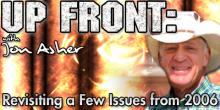 No publication worth the ink it’s printed with – although in our case
that probably means the pixels you see on your screen – lets the year
end without some sort of review. I could select the Best and Worst of
the Year, but in this instance I’ll just nominate what I think were the
most important stories of 2006. Of course, one man’s version of what
was important isn’t necessary another’s, so ultimately you’ll decide
what you think were the most meaningful stories of the past 12 months.
No publication worth the ink it’s printed with – although in our case
that probably means the pixels you see on your screen – lets the year
end without some sort of review. I could select the Best and Worst of
the Year, but in this instance I’ll just nominate what I think were the
most important stories of 2006. Of course, one man’s version of what
was important isn’t necessary another’s, so ultimately you’ll decide
what you think were the most meaningful stories of the past 12 months.
I don’t think there was one story that’s worthy of being the biggest news of the year, but unlike Time Magazine, I won’t insult you by suggesting that you are the story of year.
Looking back on the interesting stories of 2006...
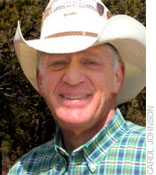 THE STORIES OF THE YEAR
THE STORIES OF THE YEAR
No publication worth the ink it’s printed with – although in our case that probably means the pixels you see on your screen – lets the year end without some sort of review. I could select the Best and Worst of the Year, but in this instance I’ll just nominate what I think were the most important stories of 2006. Of course, one man’s version of what was important isn’t necessary another’s, so ultimately you’ll decide what you think were the most meaningful stories of the past 12 months.
I don’t think there was one story that’s worthy of being the biggest news of the year, but unlike Time Magazine, I won’t insult you by suggesting that you are the story of year.
a d v e r t i s e m e n t
Click to visit our sponsor's website
THE SCHUMACHER QUALIFYING “INCIDENT” AT THE FINALS
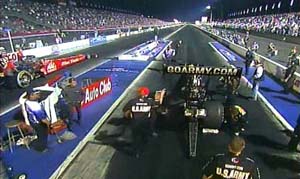 This may have been, in some respects, the biggest story of 2006. Since the world knows what happened, we won’t go over that old ground again, at least not in detail. Simplistically, Tony Schumacher’s car was leaking fluid when it approached staging in the final session on Saturday evening at Pomona. Starter Rick Stewart gave Schumacher the kill signal, which he pointedly ignored. Tuner Alan Johnson later – and rather lamely – claimed that he didn’t see the signal, and therefore didn’t tell Schumacher to shut the engine down. NHRA officials later claimed that after looking at all the video they couldn’t prove with any certainty that Johnson had seen Stewart’s signal. Observers on the scene, some of them extremely close to the action, said it appeared to them as if Johnson definitely saw Stewart’s signal. Regardless, NHRA levied a $20,000 fine against Schumacher, who then went on to win a dramatic championship by a handful of points over Doug Kalitta.
This may have been, in some respects, the biggest story of 2006. Since the world knows what happened, we won’t go over that old ground again, at least not in detail. Simplistically, Tony Schumacher’s car was leaking fluid when it approached staging in the final session on Saturday evening at Pomona. Starter Rick Stewart gave Schumacher the kill signal, which he pointedly ignored. Tuner Alan Johnson later – and rather lamely – claimed that he didn’t see the signal, and therefore didn’t tell Schumacher to shut the engine down. NHRA officials later claimed that after looking at all the video they couldn’t prove with any certainty that Johnson had seen Stewart’s signal. Observers on the scene, some of them extremely close to the action, said it appeared to them as if Johnson definitely saw Stewart’s signal. Regardless, NHRA levied a $20,000 fine against Schumacher, who then went on to win a dramatic championship by a handful of points over Doug Kalitta.In later conversations with various NHRA officials the overriding theme of their rather pathetic reasoning was that they didn’t want to be the ones deciding the POWERade championship, so they limited their punishment to a simple dollars and cents action.
No one here, certainly including me, is saying anything to detract from the rather remarkable performances Schumacher and Johnson put together to win the title. Their final round numbers were nothing short of astounding – but they never should have been allowed to happen.
Had any racer other than Tony Schumacher, with any sponsor other than the U.S. Army, done what he did, which was nothing short of blatantly disobeying a direct order from the starter, the “highest” official on the starting line, he would have been immediately and summarily disqualified from further competition. At the very least said racer would have been sent home for the balance of the weekend’s activities, and would have likely faced additional penalties, both financial and points-wise, after that.
As but one example of a blatant and dangerous rules violation, some years ago Pro Stock racer Joe Lepone was caught using an unapproved clutch when the unit exploded in the pits at Columbus when he was warming up the engine. Lepone was immediately suspended from further competition that weekend and was later “excused” from two additional national events and fined $5,000. By being sent home early from Columbus Lepone also lost his last opportunity to retain his qualified position in the Pro Stock Showdown, so in effect he was disqualified from four, not three races.
Consider the potential ramifications of Schumacher’s actions. Suppose, on the throttle hit, the engine had wound sky high and exploded as did Doug Herbert’s powerplant at Pomona not that many years ago. Fourteen people suffered shrapnel injuries in that incident, with the sport lucky to survive without fatalities. Suppose Schumacher’s car had spun wildly into the other lane, crashing into title contender Doug Kalitta’s car and injuring him in the process, keeping him out of further competition for the weekend. The negative scenarios are almost endless, with one overall theme, their negativity.
Going back to the Lepone incident as an example, one reason he was so severely punished was because of the potential situation that could have resulted from his use of that unapproved clutch. Clutch shrapnel spraying into the spectator stands is no less injurious than parts from a fuel car.
The NHRA will undoubtedly deny this hotly, but their relationship with the U.S. Army has been an overall negative since its inception because by selling their corporate souls for a sponsor for the Youth & Education program to the Army they effectively kept other branches of the military from participating in team sponsorships. Yes, it’s totally true that the NHRA is not keeping any other branch of the military from sponsoring a team, but by not enabling them to gather names for recruiting purposes as part of that sponsorship, each has realized they’d only be spending money on a billboard, not an actual recruiting-oriented marketing program. The result is that each branch of the services approached has declined to participate for these very reasons.
Can we prove that the Army’s involvement with the NHRA played a role in the Schumacher non-decision? Of course we can’t – but we nevertheless strongly believe that there was consideration given to that relationship during whatever discussions might have taken place regarding what might have been an appropriate punishment for Schumacher.
Let’s look at it this way: Had any other competitor done what Schumacher and Johnson did, they would have been met at their pit area by Graham Light or one of his representatives where they would have been politely told to load up their car for the balance of the weekend. Imagine Del Worsham, Scott Kalitta, Morgan Lucas or Hillary Will having done what Schumacher did. As non-championship contenders they would have been gone before the smoke from their burnouts had dissipated.
Like it or not, Tony Schumacher didn’t deserve to become the POWERade Top Fuel champion, and that statement’s based on his actions, not on any personal feelings we might have. When all is said and done, Tony Schumacher’s a nice young man who’s an excellent spokesman for both drag racing and the U.S. Army. But what’s right is right, and what’s wrong is wrong. And that one was way wrong.
a d v e r t i s e m e n t
Click to visit our sponsor's website
J.R.TODD
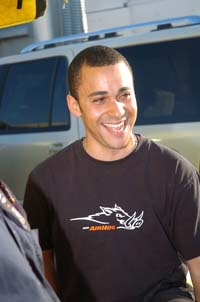 Although he ran only 19 of 23 NHRA POWERade races, Todd still finished in the Top 10. He also made four impressive final round appearances, winning a trio of races. He absolutely crushed the competition for the Auto Club’s Road to the Future Award (which desperately needs to be re-titled what it is, the Rookie of the Year) and almost single handedly kept Tony Schumacher from winning the championship. While Schumacher topped Todd four times, it was the two races in which the youngster stopped the veteran in the final rounds that helped keep the points race tight.
Although he ran only 19 of 23 NHRA POWERade races, Todd still finished in the Top 10. He also made four impressive final round appearances, winning a trio of races. He absolutely crushed the competition for the Auto Club’s Road to the Future Award (which desperately needs to be re-titled what it is, the Rookie of the Year) and almost single handedly kept Tony Schumacher from winning the championship. While Schumacher topped Todd four times, it was the two races in which the youngster stopped the veteran in the final rounds that helped keep the points race tight. Todd was the surprise winner of the Mile-High Nationals over Schumacher, and then repeated those results a few weeks later at the Fram Autolite Nationals in Sonoma. Had Todd managed a third final round victory over Schumacher in Las Vegas the Finals might have been far less dramatic.
Media and fan friendly, Todd’s on-track performances were the result of tuner Jimmy Walsh’s willingness to go for the throat at times when others might have taken a more conservative approach. The combination of Todd and Walsh will be formidable in ’07, of that there can be little doubt.
Oh! Did we forget to mention that Todd is the first African-American to win a pro category at an NHRA national event? So what? The only people who remotely cared about that were the straight press writers desperately seeking a story, any story. For drag racing fans a driver’s ethnicity has rarely been a factor in their liking or disliking someone. Run the numbers in a good looking machine, and the fans will rally to you.
It’s with more than a little irony that I note NASCAR’s highly publicized Drive for Diversity program, when drag racing has never done anything special to make women and minorities feel welcome simply because (after Shirley Muldowney fought her way to acceptance) it’s never been necessary.
Every time NASCAR put out a press release about their Drive for Diversity program the NHRA media department ended up fielding calls asking about drag racing’s version of the same. That forced the already overworked media people to once again dig out their lengthy lists of female and minority competitors while at the same time patiently explaining that drag racing didn’t need a program to fix a “problem” that didn’t exist. Maybe NASCAR needed that program because they do have a problem in that area.
a d v e r t i s e m e n t
Click to visit our sponsor's website
THE TIMER “INCIDENTS” AT ATLANTA AND COLUMBUS
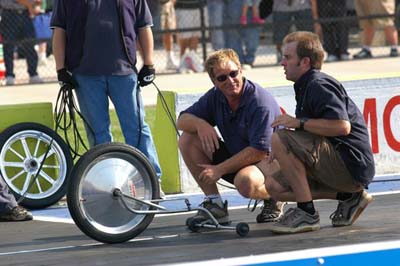 It may be ancient history by drag racing standards, but the obvious timer malfunctions that impacted the races in Atlanta and Columbus last season had a negative impact on numerous racers, and could have had championship ramifications. Just as with the Schumacher qualifying incident story, this one is also well known among both competitors and fans, but it’s still worth remembering.
It may be ancient history by drag racing standards, but the obvious timer malfunctions that impacted the races in Atlanta and Columbus last season had a negative impact on numerous racers, and could have had championship ramifications. Just as with the Schumacher qualifying incident story, this one is also well known among both competitors and fans, but it’s still worth remembering.Long after qualifying was over in Atlanta on Friday evening the NHRA arbitrarily decided to disallow four Pro Stock elapsed times, never mind that one of them had come during the first session in the afternoon some six or seven hours earlier.
Why Pro Stock was the only category to be singled out for “benefiting” from the allegedly faulty equipment in the right lane remains a mystery. More than one competitor in one of the other pro categories was given questionable times, yet none of those 60-foot numbers were even questioned. For one Funny Car driver Friday’s right lane had produced the quickest 60-foot time of his career, a time that virtually every other competitor in the class openly questioned, yet the time was allowed to stand.
Ironically, it all apparently boiled down to money, money in terms of NHRA’s apparent unwillingness to pay the freight to have the experts from Compulink on hand to make sure these problems didn’t come up. And money in their decision to buy replacement parts for the timers that Compulink had specifically warned them not to replace with off-the-shelf items from another supplier, suggesting that “stock” items wouldn’t work well with their highly modified electronics.
The same scenario took place during qualifying the following weekend in Columbus, prompting both Larry Morgan and Antron Brown to speak out about their displeasure about what was being allowed to continue – bogus times enabling possibly undeserving racers the opportunity to appear in Sunday’s eliminations.
One of those bogus timer problems did crop up on Sunday, and, just like it was at Indy two years ago, Pro Stock Motorcycle was involved. The result (long after the fact, of course) was an apology from NHRA to the affected racer and the granting of additional points and money. Of course, had the rider who got jobbed out of an appearance in the semifinal round ended the year just two or three markers out of first place, imagine the outcome had he won that semifinal round and then gone on to win the race. Those additional points could have made him the champion.
The real problem that the Atlanta and Columbus incidents brought to light is NHRA’s continuing inability to make sensible decisions when it comes to failures on their part. When racers “lose” runs due to the failure of equipment that the NHRA effectively “certifies” as being “right,” the affected drivers should be given another go at the track. Those NHRA officials will undoubtedly say that granting additional runs is unfair to those who have already run, and they have a point of sorts – but not under these circumstances. When the organization itself is at fault, they should bite the bullet, offer an apology, and direct the drivers back to the lanes for another chance.
a d v e r t i s e m e n t
Click to visit our sponsor's website
THE UNLEVEL PLAYING FIELD OF WEB SITES
Here’s another controversial subject, and one that most of you may not even be aware of, yet it affects dozens of competitors. Just as there was (and continues today) a constant battle for readers between Hot Rod, Car Craft, Popular Hot Rodding and Super Stock & Drag Illustrated when print magazines were the kings of drag racing coverage, that same battle exists now for readers of Torco’s Competitionplus.com and the numerous other web sites that cover the quarter mile. For the magazines the measuring stick was the Standard Rate & Data Service, which reported total circulation figures on a regular basis. With the Internet there’s yet to be an accepted, industry-wide reporting service, although Alexa comes closest to meeting that criteria.
Drivers and team PR people have been placed in an awkward position because some (but certainly not all) of those who represent the “official” NHRA web site have informed them that if they provide press information or even feature stories to other sites they won’t receive as much coverage from NHRA. It’s common knowledge that teams have been told if they don’t give the association’s site a 24-hour exclusive head start their material won’t be run.
We can already hear the denials, but to accept them at face value we’d then have to think a half dozen drivers and an equal number of team PR people are outright liars, and we just don’t think that’s the case.
Okay, so this little vignette is meaningless to you – but it shouldn’t be. Our aim at Torco's Competitionplus.com is to bring you the most timely and important stories about drag racing, and in all candor, that obviously demands the cooperation of drivers, team owners and team PR people. If they’re concerned about cooperating with us because they believe they’re going to be cut out of exposure on another site, everyone’s going to suffer.
Think this can’t happen? At the U.S. Nationals a racer was approached by someone from the site who asked, “Why did you give that story to the enemy?”
“I didn’t give it to the enemy,” was his reply. “I gave it to a friend.”
“Well, he’s an even bigger enemy, and if you keep doing that you’ll never see your car on our site.”
Ah, well. Maybe we’re just making this stuff up and all’s well with the world!
| {loadposition feedback} |






